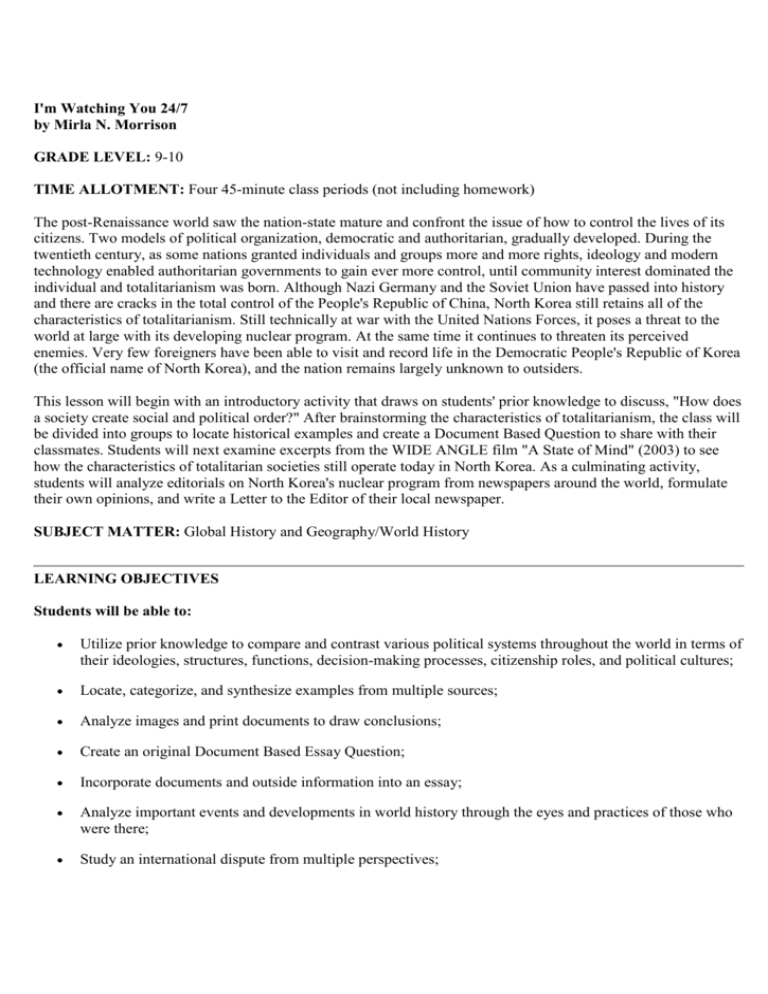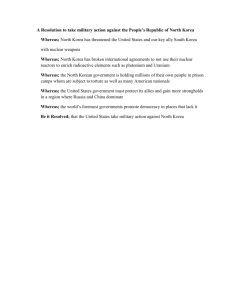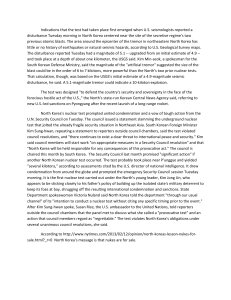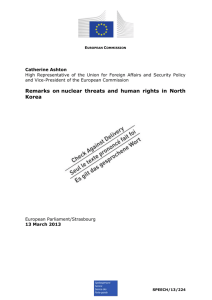
I'm Watching You 24/7
by Mirla N. Morrison
GRADE LEVEL: 9-10
TIME ALLOTMENT: Four 45-minute class periods (not including homework)
The post-Renaissance world saw the nation-state mature and confront the issue of how to control the lives of its
citizens. Two models of political organization, democratic and authoritarian, gradually developed. During the
twentieth century, as some nations granted individuals and groups more and more rights, ideology and modern
technology enabled authoritarian governments to gain ever more control, until community interest dominated the
individual and totalitarianism was born. Although Nazi Germany and the Soviet Union have passed into history
and there are cracks in the total control of the People's Republic of China, North Korea still retains all of the
characteristics of totalitarianism. Still technically at war with the United Nations Forces, it poses a threat to the
world at large with its developing nuclear program. At the same time it continues to threaten its perceived
enemies. Very few foreigners have been able to visit and record life in the Democratic People's Republic of Korea
(the official name of North Korea), and the nation remains largely unknown to outsiders.
This lesson will begin with an introductory activity that draws on students' prior knowledge to discuss, "How does
a society create social and political order?" After brainstorming the characteristics of totalitarianism, the class will
be divided into groups to locate historical examples and create a Document Based Question to share with their
classmates. Students will next examine excerpts from the WIDE ANGLE film "A State of Mind" (2003) to see
how the characteristics of totalitarian societies still operate today in North Korea. As a culminating activity,
students will analyze editorials on North Korea's nuclear program from newspapers around the world, formulate
their own opinions, and write a Letter to the Editor of their local newspaper.
SUBJECT MATTER: Global History and Geography/World History
LEARNING OBJECTIVES
Students will be able to:
Utilize prior knowledge to compare and contrast various political systems throughout the world in terms of
their ideologies, structures, functions, decision-making processes, citizenship roles, and political cultures;
Locate, categorize, and synthesize examples from multiple sources;
Analyze images and print documents to draw conclusions;
Create an original Document Based Essay Question;
Incorporate documents and outside information into an essay;
Analyze important events and developments in world history through the eyes and practices of those who
were there;
Study an international dispute from multiple perspectives;
Present an informed viewpoint on a controversial issue in a Letter to the Editor.
STANDARDS
New York State Learning Standards for Social Studies
Standards available online at http://www.emsc.nysed.gov/ciai/socst/pub/sslearn.pdf.
Standard 2. World History (commencement)
Performance Indicators:
1. Students:
Analyze changing and competing interpretations of issues, events, and developments
throughout world history.
Analyze evidence critically and demonstrate an understanding of how circumstances of
time and place influence perspective.
Standard 5. Civics, Citizenship, and Government (commencement)
Performance Indicators:
1. Students:
Compare various political systems with that of the United States in terms of ideology,
structure, function, institutions, decision-making processes, citizenship roles, and political
culture.
New York State Regents Global History and Geography Curriculum Tie-Ins
Curriculum available online at http://www.emsc.nysed.gov/ciai/socst/pub/sscore2.pdf
Unit Six: A Half Century of Crisis and Achievement (l900-l945)
B. Revolution and Change in Russia
6. Stalin and the rise of a modern totalitarian state
D. World War II: causes and impact
2. The Nazi and Japanese states
Unit Seven: The 20th Century Since l945
A. Cold War Balance of Power
6. Korean War
D. Chinese Communist revolution
3. Communism under Mao Zedong
Unit Eight: Global Connections and Interactions
D. Science and Technology
8. Nuclear proliferation
Advanced Placement World History Curriculum Tie-Ins
Course Description available online at:
http://apcentral.collegeboard.com/repository/05821apcoursdescworld_4332.pdf
(Requires the Adobe Acrobat Reader)
1914-Present:
Major Developments:
2. The World Wars, the Holocaust, the Cold War, nuclear weaponry, international organizations,
and their impact on the global framework (globalization of diplomacy and conflict; global balance
of power; reduction of European influence; the League of Nations, the United Nations, the NonAligned Nations, etc.)
5. New forces of revolution and other sources of political innovation
MEDIA COMPONENTS
Video:
WIDE ANGLE, "A State of Mind" (2003) (selected clips)
Web Sites:
For the Introductory Activity:
Keith Pictures "South Asia Protestors"
http://www.pbase.com/keithpictures/image/53709290
A photograph of young people protesting peacefully.
TIME -- The TIME 100: "The Unknown Radical"
http://www.time.com/time/time100/leaders/profile/rebel.html
The iconic image of a lone man protesting in front of a line of tanks in Tiananmen Square.
Internet Modern History Sourcebook
1. Stalinism
http://www.fordham.edu/halsall/mod/modsbook39.html#Stalinism
2. Nazism
http://www.fordham.edu/halsall/mod/modsbook43.html
3. Communism in China
http://www.fordham.edu/halsall/mod/modsbook52.html#China
The sites contain links to multiple primary source documents for each totalitarian society.
MODERN WORLD HISTORY: "Nazi Germany"
http://www.historylearningsite.co.uk/Nazi%20Germany.htm
Contains background narrative and primary source excerpts on various topics about Nazi Germany.
LIBRARY OF CONGRESS: "A Country Study"
1. The Soviet Union (former)
http://lcweb2.loc.gov/frd/cs/sutoc.html
2. China
http://lcweb2.loc.gov/frd/cs/cntoc.html
These sites provide background briefing on both the USSR and the People's Republic of China
Google Images
1. USSR
http://images.google.com/images?q=Union+Soviet+Socialist+republic&hl=en&btnG=Search+Ima
ges
2. People's Republic of China
http://images.google.com/images?svnum=10&hl=en&lr=&q=Peoples+Republic+China&btnG=Sea
rchl
3. Nazi Germany
http://images.google.com/images?svnum=10&hl=en&lr=&q=Nazi+germany
The site provides multiple images, maps, and posters about the USSR, the People's Republic of China, and
Nazi Germany.
WIDE ANGLE: " A State of Mind" Timeline
http://www.pbs.org/wnet/wideangle/shows/northkorea/timeline1.html
This site contains a comprehensive timeline of modern North Korean history.
For the Culminating Activity:
Worldpress.org: "Nuclear North Korea"
http://www.worldpress.org/Asia/904.cfm
Editorial opinion from 16 newspapers located in Pyongyang, Seoul, Tokyo, Madrid, London, Chennai,
Islamabad, Beijing, Toronto, Tehran, Brisbane, and Melbourne, January 8, 2003.
Voice of America: "U.S. Considers Taking North Korea Nuclear Issue to UN"
http://www.voanews.com/english/archive/2005-06/2005-06-05voa5.cfm?CFID=42346332&CFTOKEN=60140473
An American site that discusses the issue from the perspective of the United States.
MATERIALS
For the class:
Computer monitor or computer connection to television/projector for clip viewing
Large-screen projection device (optional)
Computers with access to the Internet
Chalkboard/Whiteboard
Overhead transparency made from "How Does a Society Create Social and Political Order?" student
organizer
Overhead transparency of web diagram of the "Characteristics of a Totalitarian Society" web diagram
Possible Student Answers: "How Does a Society Create Social and Political Order?" student organizer
Possible Students Answers: "Viewpoints on Nuclear North Korea" chart
Per group of five students:
Web of the "Characteristics of a Totalitarian Society" web diagram
For each pair of students:
"How Does a Society Create Social and Political Order?" student organizer
For each student:
"Planning Pages for Group-Created Document Based Question on the Characteristics of Totalitarianism"
"Viewpoints on Nuclear North Korea" chart
PREP FOR TEACHERS
Prior to teaching this lesson, you will need to:
Bookmark the Web sites used in the lesson on each computer in your classroom, or upload all links to an online
bookmarking utility such as www.portaportal.com.
Preview all of the video clips and Web sites used in the lesson to make certain that they are appropriate for your
students, currently available, and accessible from your classroom.
Download the video clips used in this lesson onto your hard drive, or prepare to stream the clips from your
classroom. RealPlayer is needed to view the video clips. If your classroom computer does not have it, download
RealPlayer for free at www.real.com.
Prepare an overhead transparency from the student organizer entitled "How Does a Society Create Social and
Political Order?"
Post an enlarged "Characteristics of a Totalitarian Society" web diagram on the wall or board.
Make enough copies for the class of the student organizers:
"How Does a Society Create Social and Political Order?"
"Planning Pages for Group-Created Document Based Question on the Characteristics of Totalitarianism"
"Viewpoints on Nuclear North Korea"
Review the answers for "How Does a Society Create Social and Political Order?" and "Viewpoints on Nuclear
North Korea" found in the Organizers for Students section of this lesson plan.
When using media, provide students with a FOCUS FOR MEDIA INTERACTION, a specific task to complete
and/or information to identify during or after viewing of video segments, Web sites, or other multimedia elements.
Post the FOCUS FOR MEDIA INTERACTION questions included in the Introductory Activity on the wall, or
write them on the board, or have them ready to project.
For additional background material on North Korea the teacher should consult the Web site for WIDE ANGLE:
"A State of Mind," available online at http://www.pbs.org/wnet/wideangle/shows/northkorea/index.html.
If background on teaching with and creating Document Based Questions is needed, review the New York State
Education Department's online resource, at http://www.emsc.nysed.gov/ciai/socst/dbq/ssindex.html.
Procedures for Teachers
INTRODUCTORY ACTIVITY:
1. Display the images "South Asia Protestors" and "The Unknown Radical" and provide students with a
FOCUS FOR MEDIA INTERACTION, asking them to jot down what they see in each image. Then ask
the students what the differences are between the two images (the protest in South Asia is peaceful, the
protest in Tiananmen Square shows the power of the state to control what people do and say). Tell the
students that they are going to look at different forms of government and begin to explore how they gain
power and control their citizens.
2. 2) Distribute the "How Does a Society Create Social and Political Order?" student organizer. Give the
class five minutes to work in pairs to fill in the answers. Project the worksheet on an overhead
transparency and discuss the answers as a class. An answer key is provided in the Organizers for Students
section.
3. Explain to students that during the 20th century -- as some nations granted individuals and groups more
and more rights -- ideology and modern technology enabled authoritarian societies to gain ever more
control. In those societies, community interest dominated the individual, and totalitarianism was born. Ask
the students for a definition of totalitarianism. (The political concept that the citizen should be totally
subject to an absolute state authority.) Post the definition on your word wall, if you have one.
4. If you have already taught the characteristics of totalitarianism, ask the students what the characteristics
are and list them on the board along with the historical examples. (Nazi Germany, USSR, People's
Republic of China.) If this material will be new to your students, project or post the "Characteristics of a
Totalitarian Society" web diagram and briefly discuss each characteristic and the historical examples of
totalitarian states.
5. Divide the class into groups and distribute the "Planning Page for Document Based Question on
Totalitarianism." Provide students with a FOCUS FOR MEDIA INTERACTION, telling them they are
going to locate six documents to provide examples of the characteristics of totalitarianism from the list of
Web sites on their Planning Pages. The documents can include text, images, cartoons, and charts and they
must include six different characteristics. Review the Planning Page with the class and give them time to
plan as a group, and if desired, time to begin to review the Web sites. The project will be completed for
homework over the next week.
When the DBQs (Document Based Questions) are completed, duplicate them, distribute them to students
other than the developers, and have them share what they have created. As an option the students might
actually write the essay for homework.
LEARNING ACTIVITY #1
1. Tell your students that they will be having a rare chance to see into North Korea, the most totalitarian
society on earth in this century. They are going to analyze whether this contemporary nation uses the same
methods as the historical examples they have already studied to control its citizens. (If the class has not yet
studied about Korea, explain the following background to the class: in the middle of the 20th Century, the
northern part of Korea, that had adopted a Communist form of government, invaded the South. Three
years of brutal fighting followed against United States-led United Nations forces. North Korea calls the
war "The Victorious Fatherland Liberation War," and maintains it was begun by the U.S. imperialists. It
does not recognize that the North began the war. Although there is currently an armistice, for the North
Koreans the war has never ended and the hatred of the United States is enormous. As Pak Hyon Sun, a
young gymnast says in the video, "As we're taught in school, we have to endlessly hate the U.S. and fight
them to the end." North Korea remains a closed society that threatens to test nuclear weapons and delivery
systems.)
2. Explain that the video introduces the Workers Party of Korea and the only two leaders North Korea has
had. Kim Il Sung, "The Great Leader," led the country from 1948 until his death in 1994. In 1998 he was
proclaimed Eternal President. Kim Jong Il, his son, is the current leader. He is called, "The General" or
"The Dear Leader." Note for the students that in Korean, the last name is written first. Thus, Kim is the last
name, and Jong Il the first and middle names. The video profiles two young gymnasts, Pak Hyon Sun and
Kim Song Yon, and the Pak and Kim families. One family is working class, and the other is in the
intellectual class. They live in the capital city, Pyongyang. Living in the modern city of Pyongyang is a
privilege. Finally, explain that North Korean communist ideology is based on the concept of "juche,"
which means self-reliance.
3. Ask students to brainstorm what they would like to know about North Korea. Post or write on the board
the items they suggest. Leave them up until the completion of the lesson. Remind students of the
"Characteristics of a Totalitarian Society" web diagram that is posted on the wall or board.
LEARNING ACTIVITY #2
1. Provide students with a FOCUS FOR MEDIA INTERACTION, asking them to look for examples of the
characteristics of totalitarianism as they watch the video clip. PLAY Clip 1, "One Party," for the class. Ask
students to pair/share what they observed, and then elicit class responses. (Students may answer: one party,
anyone can belong but must devote lives to party and leader; realistic art that serves as propaganda, all
officially equal.) As students respond ask them which characteristics of totalitarianism their examples
support.
2. Explain to the students that the BBC crew who filmed this video in 2003 had previously received
permission to film the story of the forgotten North Korean soccer team that won the World Cup in 1966.
The film they produced, THE GAME OF THEIR LIVES was shown seven times in North Korea in 2003
to great acclaim. Because of this the film crew was granted permission to document the lives and the
families of two girls who are involved in mass gymnastics. Both families live in the capital, Pyongyang.
Throughout the filming there were guides and interpreters for the film crew, but there was no censorship
during the shoot.
3. Provide students with a FOCUS FOR MEDIA INTERACTION, asking them to be ready to share all the
adjectives they can think of to describe the Mass Games. PLAY Clip 2, "Mass Games," for the class.
Create a word splash on the board with all the adjectives the class brainstorms. (Responses will vary.) Ask
the class why Hyon Sun says she is so happy to perform in front of the General. (He is the leader of the
country.) What functions do the Mass Games serve for the government? (The performance embodies the
ideology of the state -- the subordination of individual thoughts and actions to the needs of the collective.)
Once again, ask the students to connect their responses to the characteristics of totalitarianism posted in
the classroom.
LEARNING ACTIVITY #3
1. Tell the students that during the Korean War the capital, Pyongyang, was almost totally destroyed. Ask the
students to provide ideas: how might a totalitarian government go about rebuilding a city? (Students may
reply that people would be forced to be part of rebuilding crews, the government would set the goals, the
capital would be rebuilt grander than ever for propaganda purposes, the capital would be rebuilt in another
place, living conditions will be better than elsewhere). [Clip 3] Provide students with a FOCUS FOR
MEDIA INTERACTION, asking the students to check to see if their predictions are validated by the video
clip. PLAY Clip 3, "All for One," for the class. After viewing, discuss whether the predictions made by
your students were accurate. Ask what is meant when the narrator describes Pyongyang as a "showcase" (a
city that reflects successes of the government). Ask the students to describe the streets. (Very wide, no
cars, few people, no motorbikes or bicycles). Ask the students to describe the living conditions of the Pak
family. (Apartment in high rise modern building, grandparents sleep on the floor, does have furniture and
decorative objects, portraits of the leaders on wall with slogan, radio piped into kitchen that cannot be
disconnected and is always on, TV channels and time regulated.)
2. Ask your students to identify the kinds of problems they think the government of North Korea faced after
it took power. (Students may reply people trying to leave, natural disasters, food shortages, epidemics,
blockades, or embargos on trade) [CLIP 4] Provide students with a FOCUS FOR MEDIA
INTERACTION, asking them to identify the greatest problem North Korea has faced in the past fifty
years, and to evaluate whether it still continues. PLAY Clip 4, "Arduous March," for the class. Discuss
what the Arduous March is. (The famine that occurred in North Korea in the 1990s. It is estimated that two
million people died.) Ask the students to describe the example Kim Song Yon's mother gives of her
daughter's birthday. (She had one ear of corn that she ground up. She gave each child a half bowl of
porridge and the birthday girl a whole bowl.) How does she describe what they have to eat now?
(Rationing: one chicken and five eggs per month for each family member. She says, "It is much better
now.") The narrator comments that critics thought the regime would collapse during the Arduous March.
Ask the students why they think it didn't? (Student answers will vary.)
LEARNING ACTIVITY #4
1. Remind students that Pyongyang is a showcase city and the families we saw are part of the privileged two
million that live there. Ask the students which class in North Korean society have we not yet seen?
(Peasants.) Point out that permission is needed to travel outside of the capital, and this video is the first
ever allowed to be made in the countryside to visit a friend of one of the families. [CLIP 5] Provide
students with a FOCUS FOR MEDIA INTERACTION, asking them to watch for indications of whether
the peasants are happy under the government of Kim Jong Il. PLAY Clip 5, "Self-Reliance," for the class.
Discuss the clues the class saw about life on the farm. (Hard work, drought, little government help.) What
does the peasant who is being interviewed claim enables them to succeed? (Self-reliance or "juche") Can
we tell if the peasants are happy? (Student answers may vary, but point out it is impossible to tell in a
closed society where access to individuals is controlled by the government.)
2. Return to the "Characteristics of a Totalitarian Society" web diagram that you have posted and ask the
students to point out additional examples of each characteristic from the video segments about North
Korea. If any questions on the brainstormed list (See Learning Activity, step 3) remain unanswered, they
can be assigned for extra credit or homework.
CULMINATING ACTIVITY
1. Present students with the following quotation from the official Web site of the Democratic People's
Republic of North Korea: "In the defence (sic) area the Juche (self reliance) idea means Self Defence. It's a
basic point to warrant the protection of the country using an invincible military power that will protect the
motherland and revolutionary achievements from the aggressive Yankee imperialism and its servants."
Ask students what North Korea means by "invincible military power?" (Students may answer
overwhelming army -- make sure they mention nuclear weapons.) Who do they want to protect the
fatherland from? (Yankee -- United States --imperialism and its servants -- Europe, South Korea, Japan.)
2. Direct the students to the following two Web Sites and provide students with a FOCUS FOR MEDIA
INTERACTION, asking them to look at the various world views on the North Korean nuclear issue and to
identify the position of the newspapers of five different countries. Distribute the student organizer entitled
"Viewpoints on Nuclear North Korea." Instruct students to choose five newspapers, each from a different
country. Check to make sure that all countries are covered by your students.
Worldpress.org: "Nuclear North Korea"
http://www.worldpress.org/Asia/904.cfm
Voice of America: "U.S. Considers Taking North Korea Nuclear Issue to U.N."
http://www.voanews.com/english/archive/2005-06/2005-06-05voa5.cfm?CFID=42346332&CFTOKEN=60140473
This activity may be done in class if enough computers are available, or for homework.
3. Conduct a class discussion about the position of the various countries. Have students construct a T-chart to
record the arguments for and against North Korea's development of nuclear weapons. An answer key is
provided.
4. To conclude, ask your students to write a Letter to the Editor of a local newspaper, elaborating their
suggestions as to how to resolve the North Korean nuclear issue. Ask students to support their suggestions
with specific examples.
ADDITIONS FOR ADVANCED PLACEMENT WORLD HISTORY
The Document Based Question is required on the Advanced Placement examination in World History as well as
on the New York State Regents in Global History. The teacher can tailor the DBQ assignment for the Advanced
Placement level by increasing the complexity and depth of understanding required. (Note to the Teacher: an
example of a "Do-It-Yourself DBQ Project" is found on page 46 of Teacher's Guide -- AP World History by Joan
Arno. It is published by the College Entrance Examination Board, 2000.) The essay in response to the question
requires both incorporation of information from the documents and outside information the student brings to the
task.
When the DBQs created by the students are completed, duplicate them, and distribute them to students other than
the developers. Have them write their essay after the Learning Activity is completed. Tell the students they may
incorporate examples shown in the "A State of Mind" video clips in their essays as part of their outside
information.
CROSS-CURRICULAR EXTENSIONS
Language Arts
Have the students read either the novel by Aleksandr Solzhenitsyn, ONE DAY IN THE LIFE OF IVAN
DENISOVICH (New York: Signet Classics, 1974) or the excerpt found at the Amazon.com Web site.
Compare the novel with the factual information gained in Social Studies.
Science
Investigate the biological impact of a nuclear explosion on people and their environment.
Display propaganda posters and analyze the artistic techniques used by the artists. Have students create
their own propaganda poster using those techniques to promote a cause of their own choosing.
Art
COMMUNITY CONNECTIONS:
Contact the local American Legion Post or Veterans of Foreign Wars and request a speaker who has been posted
in the DMZ (demilitarized zone) between North and South Korea.
Invite a speaker from an anti-nuclear group to speak to the class about threats to the world from nuclear
proliferation.
Have the students write questions for the speaker before she/he comes to class.
© 2006 Educational
Broadcasting Corporation.
All Rights Reserved.
close this window
Funding for WIDE ANGLE: WINDOW
INTO GLOBAL HISTORY is provided by
the Corporation for Public Broadcasting and
the J.P. Morgan Chase Foundation.









